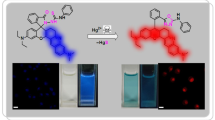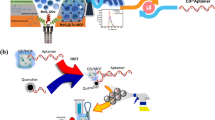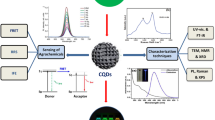Abstract
Excessive Cd2+ poses adverse influences on ecosystem and human beings, but its precise detection via a facile and environment-friendly method with resistance to interference is still a challenge. Here, a turn-on ratiometric fluorescent nanoprobe for Cd2+ detection is established using yellow-emission AgInZnS quantum dots (AIZS QDs) and blue-emission nitrogen-doped graphene quantum dots (NGQDs), which serve as a recognition unit and internal reference signal, respectively. Cd2+ could enhance the fluorescence of AIZS QDs due to the passivation of surface defects, while it has no significant effect on that of NGQDs. This nanoprobe has a large detection range from 0.5 to 100 µM and a limit of detection low to 28.6 nM. It shows strong anti-interference ability for Cd2+ even in lake water samples with recovery from 98 to 101% and low relative standard deviation of 1.01%, indicating its excellent effectuation to real-application world.
Graphical abstract






Similar content being viewed by others

References
Zhou Y, He QG, Yang Y, Zhong HZ, He C, Sang G, Liu W, Yang CH, Bai FL, Li YF (2008) Binaphthyl-containing green-and red-emitting molecules for solution-processable organic light-emitting diodes. Adv Funct Mater 18:3299–3306
Zhao R, Wang Z, Tian X, Shu H, Yang Y, Xiao X, Wang Y (2021) Excellent fluorescence detection of Cu2+ in water system using N-acetyl-l-cysteines modified CdS quantum dots as fluorescence probe. Nanotechnology 32:405707
Xiong Q, Yang J, Ding H, Du J, Tang X, Shi T, Liu Z, Wu D, Lin H, Leng Y (2020) Low-threshold amplification of spontaneous emission from AgInS2 quantum dots. J Mater Chem C 8:8515–8520
Liu YF, Deng M, Zhu T, Tang XS, Han S, Huang W, Shi YL, Liu AP (2017) The synthesis of water-dispersible zinc doped AgInS2 quantum dots and their application in Cu2+ detection. J Lumin 192:547–554
Liu YF, Tang XS, Zhu T, Deng M, Ikechukwu IP, Yin GL, Bai YZ, Qu DR, Huang XB, Qiu F (2018) All–inorganic CsPbBr3 perovskite quantum dots as photoluminescent probe for ultrasensitive Cu2+ detection. J Mater Chem C 6:4793–4799
Chen H, Chao PJ, Han DB, Wang H, Miao JS, Zhong HZ, Meng H, He F (2017) Hydroxyl-terminated CuInS2-based quantum dots: potential cathode interfacial modifiers for efficient inverted polymer solar cells. ACS Appl Mater Interfaces 9:7362–7367
Sun Y, Song F, Qian C, Peng K, Sun S, Zhao Y, Bai Z, Tang J, Wu S, Ali H (2017) High-Q microcavity enhanced optical properties of CuInS2/ZnS colloidal quantum dots toward non-photodegradation. ACS Photonics 4:369–377
Gui RJ, An XQ, Su HJ, Shen WG, Chen ZY, Wang XY (2012) A near-infrared-emitting CdTe/CdS core/shell quantum dots-based OFF–ON fluorescence sensor for highly selective and sensitive detection of Cd2+. Talanta 94:257–262
Banerjee S, Kara S, Santra S (2008) A simple strategy for quantum dot assisted selective detection of cadmium ions. Chem Comm 26:3037–3039
Liu SY, Li YY, Su XG (2012) Determination of copper(II) and cadmium(II) based on ternary CuInS2 quantum dots. Anal Methods 4:1365–1370
Liu YF, Zhu T, Deng M, Tang XS, Han S, Liu AP, Bai YZ, Qu DR, Huang XB, Qiu F (2018) Selective and sensitive detection of copper (II) based on fluorescent zinc-doped AgInS2 quantum dots. J Lumin 201:182–188
Liu YF, Deng M, Tang XS, Zhu T, Zang ZG, Zeng XF, Han S (2016) Luminescent AIZS-GO nanocomposites as fluorescent probe for detecting copper(II) ion. Sens Actuators B–Chem 233:25–30
Wang YH, Zhang C, Chen XC, Yang B, Yang L, Jiang CL, Zhang ZP (2016) Ratiometric fluorescent paper sensor utilizing hybrid carbon dots–quantum dots for the visual determination of copper ions. Nanoscale 8:5977–5984
Liu DB, Wang SJ, Swierczewska M, Huang XL, Bhirde AA, Sun JS, Wang Z, Yang M, Jiang XY, Chen XY (2012) Highly robust, recyclable displacement assay for mercuric ions in aqueous solutions and living cells. ACS Nano 6:10999–11008
Yang P, Zhao Y, Lu Y, Xu QZ, Xu XW, Dong L, Yu SH (2011) Phenol formaldehyde resin nanoparticles loaded with CdTe quantum dots: a fluorescence resonance energy transfer probe for optical visual detection of copper (II) ions. ACS Nano 5:2147–2154
Yang Y, Wei Q, Zou T, Kong Y, Su L, Ma D, Wang Y (2020) Dual-emission ratiometric fluorescent detection of dinotefuran based on sulfur-doped carbon quantum dots and copper nanocluster hybrid. Sens Actuators B: Chem 321:128534
Xue L, Li GP, Liu Q, Wang HH, Liu C, Ding XL, He SG, Jiang H (2011) Ratiometric fluorescent sensor based on inhibition of resonance for detection of cadmium in aqueous solution and living cells. Inorg Chem 50:3680–3690
Li W, Zhang X, Hu X, Shi Y, Li Z, Huang X, Zhang W, Zhang D, Zou X, Shi J (2021) A smartphone-integrated ratiometric fluorescence sensor for visual detection of cadmium ions. J Hazard Mater 408:124872
Gui R, An X, Huang W (2013) An improved method for ratiometric fluorescence detection of pH and Cd2+ using fluorescein isothiocyanate–quantum dots conjugates. Anal Chim Acta 767:134–140
Qian J, Wang K, Wang C, Ren C, Liu Q, Hao N, Wang K (2017) Ratiometric fluorescence nanosensor for selective and visual detection of cadmium ions using quencher displacement-induced fluorescence recovery of CdTe quantum dots-based hybrid probe. Sens Actuators B: Chem 241:1153–1160
Gao X, Ma Z, Sun M, Liu X, Zhong K, Tang L, Li X, Li J (2022) A highly sensitive ratiometric fluorescent sensor for copper ions and cadmium ions in scallops based on nitrogen doped graphene quantum dots cooperating with gold nanoclusters. Food Chem 369:130964
Liu YF, Tang XS, Deng M, Zhu T, Bai YZ, Qu DR, Huang XB, Qiu F (2018) One-step aqueous synthesis of highly luminescent hydrophilic AgInZnS quantum dots. J Lumin 202:71–76
Bauer TL, Randomized A (2009) Controlled trial of financial incentives for smoking cessation. Yearb Oncol 2009:129–130
Wang L, Li WT, Wu B, Li Z, Wang SL, Liu Y, Pan DY, Wu MH (2016) Facile synthesis of fluorescent graphene quantum dots from coffee grounds for bioimaging and sensing. Chem Eng J 300:75–82
Qu Z, Na W, Nie Y, Su X (2018) A novel fluorimetric sensing strategy for highly sensitive detection of phytic acid and hydrogen peroxide. Anal Chim Acta 1039:74–81
Yan ZY, Qu XC, Niu QQ, Tian CQ, Fan CJ, Ye BF (2016) A green synthesis of highly fluorescent nitrogen-doped graphene quantum dots for the highly sensitive and selective detection of mercury (II) ions and biothiols. Anal Methods 8:1565–1571
Lin H, Yang J, Liu Y-F, Zeng F-J, Tang X-S, Yao Z-Q, Guan H-L, Xiong Q, Zhou J-E, Wu D-F (2020) Stable and efficient hybrid Ag-In-S/ZnS@SiO2-carbon quantum dots nanocomposites for white light-emitting diodes. Chem Eng J 393:124654
Cao BM, Yuan C, Liu BH, Jiang CL, Guan GJ, Han M-Y (2013) Ratiometric fluorescence detection of mercuric ion based on the nanohybrid of fluorescence carbon dots and quantum dots. Anal Chim Acta 786:146–152
Fong JFY, Chin SF, Ng SM (2016) A unique “turn-on” fluorescence signalling strategy for highly specific detection of ascorbic acid using carbon dots as sensing probe. Biosens Bioelectron 85:844–852
Liu Y, Tang X, Deng M, Zhu T, Edman L, Wang J (2021) Hydrophilic AgInZnS quantum dots as a fluorescent turn-on probe for cd2+ detection. J Alloys Compd 864:158109
Zhang Y, Zhang ZL, Yin DH, Li J, Xie RG, Yang WS (2013) Turn-on fluorescent InP nanoprobe for detection of cadmium ions with high selectivity and sensitivity. ACS Appl Mater Inter 5:9709–9713
Luo XB, Wu WB, Deng F, Chen DZ, Luo SL, Au C (2014) Quantum dot-based turn-on fluorescent probe for imaging intracellular zinc (II) and cadmium (II) ions. Microchim Acta 181:1361–1367
Wu P, Yan XP (2010) A simple chemical etching strategy to generate “ion-imprinted” sites on the surface of quantum dots for selective fluorescence turn-on detecting of metal ions. Chem Commun 46:7046–7048
Acknowledgements
The authors acknowledge generous support from J. C. Kempes Minnes Stipendiefond (No. SMK-1849.1), the Swedish Energy Agency (Nos. 45419-1, 46523-1, and 50779-1), Bertil & Britt Svenssons stiftelse för belysningsteknik, the Swedish Foundation for International Cooperation in Research and Higher Education via an Initiation Grant for Internationalization (No. 2019-8553).
Author information
Authors and Affiliations
Contributions
YL contributed to conceptualization, methodology, writing—original draft. YT contributed to supervision. ZG contributed to data curation, XS contributed to software, visualization. JY contributed to software, visualization. XT contributed to supervision. JW contributed to formal analysis. WC contributed to validation, investigation. HL contributed to data curation. MD contributed to supervision. TZ contributed to supervision, funding acquisition.
Corresponding authors
Ethics declarations
Conflict of interest
The authors declare that they have no known competing financial interests or personal relationships that could have appeared to influence the work reported in this paper.
Additional information
Handling Editor: Catalin Croitoru.
Publisher's Note
Springer Nature remains neutral with regard to jurisdictional claims in published maps and institutional affiliations.
Supplementary Information
Below is the link to the electronic supplementary material.
Rights and permissions
Springer Nature or its licensor holds exclusive rights to this article under a publishing agreement with the author(s) or other rightsholder(s); author self-archiving of the accepted manuscript version of this article is solely governed by the terms of such publishing agreement and applicable law.
About this article
Cite this article
Liu, Y., Gao, Z., Shao, X. et al. A turn-on ratiometric fluorescent nanoprobe based on AgInZnS and nitrogen-doped graphene quantum dots for Cd2+ detection in lake water. J Mater Sci 57, 17336–17346 (2022). https://doi.org/10.1007/s10853-022-07721-8
Received:
Accepted:
Published:
Issue Date:
DOI: https://doi.org/10.1007/s10853-022-07721-8



